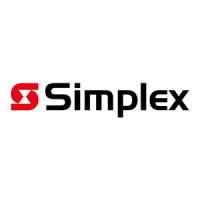3. Press the <DISABLE> key. The alphanumeric display shows the following message.
I
Press <ENTER> to DISABLE
MONITOR ZONE: ZNXX
NOTE:
XX = the point to be disabled.
4. Press the <ENTER> key. The alphanumeric display shows the action taken.
I
ACTION TAKEN
NOTE:
The system indicates a trouble condition each time a point is disabled. Press the cTBL ACK> key
as required.
5. Repeat steps 2 through 4 above to disable additional points.
IMPORTANT
REPAIR/REPLACE THE FAILED CIRCUIT/DEVICE AS SOON AS POSSIBLE. ONCE REPAIRED, THE
DISABLED POINT SHOULD BE ENABLED AS SOON AS POSSIBLE.
(See Section 10, How To Enable
A Disabled Point.)
TROUBLE INDICATIONS FOR TrueAlarmTM SENSORS
INTRODUCTION
The devices that are used for the TrueAlarmTM operation are considered sensors instead of detectors, because
these devices do not determine alarm conditions. The TrueAlarmTM
smoke sensor is a measuring device that sends
data regarding smoke density to the NDU control panel. The TrueAlarm
TM heat sensor operates in a similar fashion,
but sends temperature data instead of smoke density data. The NDU uses this data to determine whether a trouble
has occurred. This basic operational difference is the key to TrueAlarmTM operation.
The TrueAlarmTM sensor has two automatic trouble indications:
l
Dirty, and
l
Excessively Dirty.
A sensor “dirty” trouble condition is reported any time the average value on an individual sensor reaches a set
threshold value.
A sensor “excessively dirty” trouble condition is reported anytime the average value of an individual sensor reaches
a slightly higher threshold level. Although an “excessively dirty” trouble is reported, the sensor will continue to
operate and will report an alarm condition if one is detected.
In addition to the two automatic trouble conditions, the 4120 software includes a preprogrammed digital pseudo point
(P132, Sensor Almost Dirty Log Enable) that can be turned ON at the NDU front panel and the owner node to allow
a TrueAlarmTM sensor that is close to being a “dirty” sensor to report as if it were one. This is useful when
maintenance is being scheduled for dirty sensors, as it provides a means of seeing if other sensors are approaching
a “dirty” state.
19

